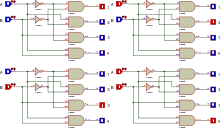220:
17:
117:
The address decoder uses the different combinatorial logic to place the memory modules or chips in the address space of a processor. The memory modules often have a smaller capacity than the address space. In most cases, several modules can be used, even if they are completely identical in structure.
40:
bits and one or more outputs for device selection signals. When the address for a particular device appears on the address inputs, the decoder asserts the selection output for that device. A dedicated, single-output address decoder may be incorporated into each device on an address bus, or a single
87:
Such a memory cell consists of a fixed number of memory elements or bits. The address decoder is connected to an address bus and reads the address created there. Using a special switching logic, it uses this address to calculate which memory cell is to be accessed. It then selects that cell by
52:
can be used as address decoders. For example, when used as an address decoder, the 74154 provides four address inputs and sixteen (i.e., 2) device selector outputs. An address decoder is a particular use of a
106:
For this purpose, the memory modules or memory chips have selection inputs, usually referred to as chip select pin (CS) or chip enable pin (CE) pin. These inputs often have a negative logic function (
103:
An address decoder is also used to select the appropriate one of multiple memory modules or memory chips when a particular address is provided by the processor system's address bus.
84:
An address decoder is a commonly used component in microelectronics that is used to select memory cells in randomly addressable memory devices.
261:
73:
45:
92:), there are row and column select lines on the memory matrix, which are controlled by address decoders integrated in the chip.
187:
160:
95:
Depending on the type of decoder, the logic used to select the memory cell can under certain circumstances be programmable.
61:" or "demux" (the 74154 is commonly called a "4-to-16 demultiplexer"), which has many other uses besides address decoding.
254:
285:
247:
89:
88:
selecting it via a special control line. This line is also known as the select line. In dynamic memories (
280:
44:
A single address decoder with n address input bits can serve up to 2 devices. Several members of the
202:
147:
152:
68:. They are represented in all integrated circuit families and processes and in all standard
8:
235:
25:
49:
227:
183:
156:
177:
76:
libraries. They are discussed in introductory textbooks in digital logic design.
65:
231:
54:
33:
274:
142:
138:
58:
37:
219:
114:), i. H. with an adjacent logical zero (voltage level low) is selected.
98:
79:
64:
Address decoders are fundamental building blocks for systems that use
137:
16:
69:
118:
It must be ensured that they differ in the address range.
99:
Address decoder selects the appropriate memory module
151:(2nd ed.). Cambridge University Press. p.
80:
Address decoder selects the storage cell in a memory
182:(2nd ed.). Ellis Horwood. pp. 489–494.
272:
255:
175:
41:address decoder may serve multiple devices.
262:
248:
15:
273:
179:Digital and microprocessor engineering
133:
131:
214:
128:
20:The four states of a 2-to-4 decoder
13:
14:
297:
218:
36:that has two or more inputs for
196:
169:
1:
121:
234:. You can help Knowledge by
7:
10:
302:
213:
286:Computer hardware stubs
203:Datasheet for 74HCT154
148:The Art of Electronics
21:
176:S. J. Cahill (1993).
19:
57:circuit known as a "
50:integrated circuits
26:digital electronics
22:
243:
242:
228:computer hardware
189:978-0-13-213398-2
162:978-0-521-37095-0
293:
281:Digital circuits
264:
257:
250:
222:
215:
205:
200:
194:
193:
173:
167:
166:
135:
113:
109:
301:
300:
296:
295:
294:
292:
291:
290:
271:
270:
269:
268:
211:
209:
208:
201:
197:
190:
174:
170:
163:
136:
129:
124:
111:
107:
101:
82:
30:address decoder
12:
11:
5:
299:
289:
288:
283:
267:
266:
259:
252:
244:
241:
240:
223:
207:
206:
195:
188:
168:
161:
126:
125:
123:
120:
100:
97:
81:
78:
55:binary decoder
34:binary decoder
9:
6:
4:
3:
2:
298:
287:
284:
282:
279:
278:
276:
265:
260:
258:
253:
251:
246:
245:
239:
237:
233:
230:article is a
229:
224:
221:
217:
216:
212:
204:
199:
191:
185:
181:
180:
172:
164:
158:
154:
150:
149:
144:
143:Winfield Hill
140:
139:Paul Horowitz
134:
132:
127:
119:
115:
104:
96:
93:
91:
85:
77:
75:
71:
67:
62:
60:
59:demultiplexer
56:
51:
47:
42:
39:
35:
31:
27:
18:
236:expanding it
225:
210:
198:
178:
171:
146:
116:
105:
102:
94:
86:
83:
63:
43:
29:
23:
46:7400 series
275:Categories
122:References
145:(1989).
153:685,766
38:address
186:
159:
226:This
66:buses
32:is a
28:, an
232:stub
184:ISBN
157:ISBN
141:and
90:DRAM
74:ASIC
72:and
70:FPGA
110:or
48:of
24:In
277::
155:.
130:^
112:CE
108:CS
263:e
256:t
249:v
238:.
192:.
165:.
Text is available under the Creative Commons Attribution-ShareAlike License. Additional terms may apply.
